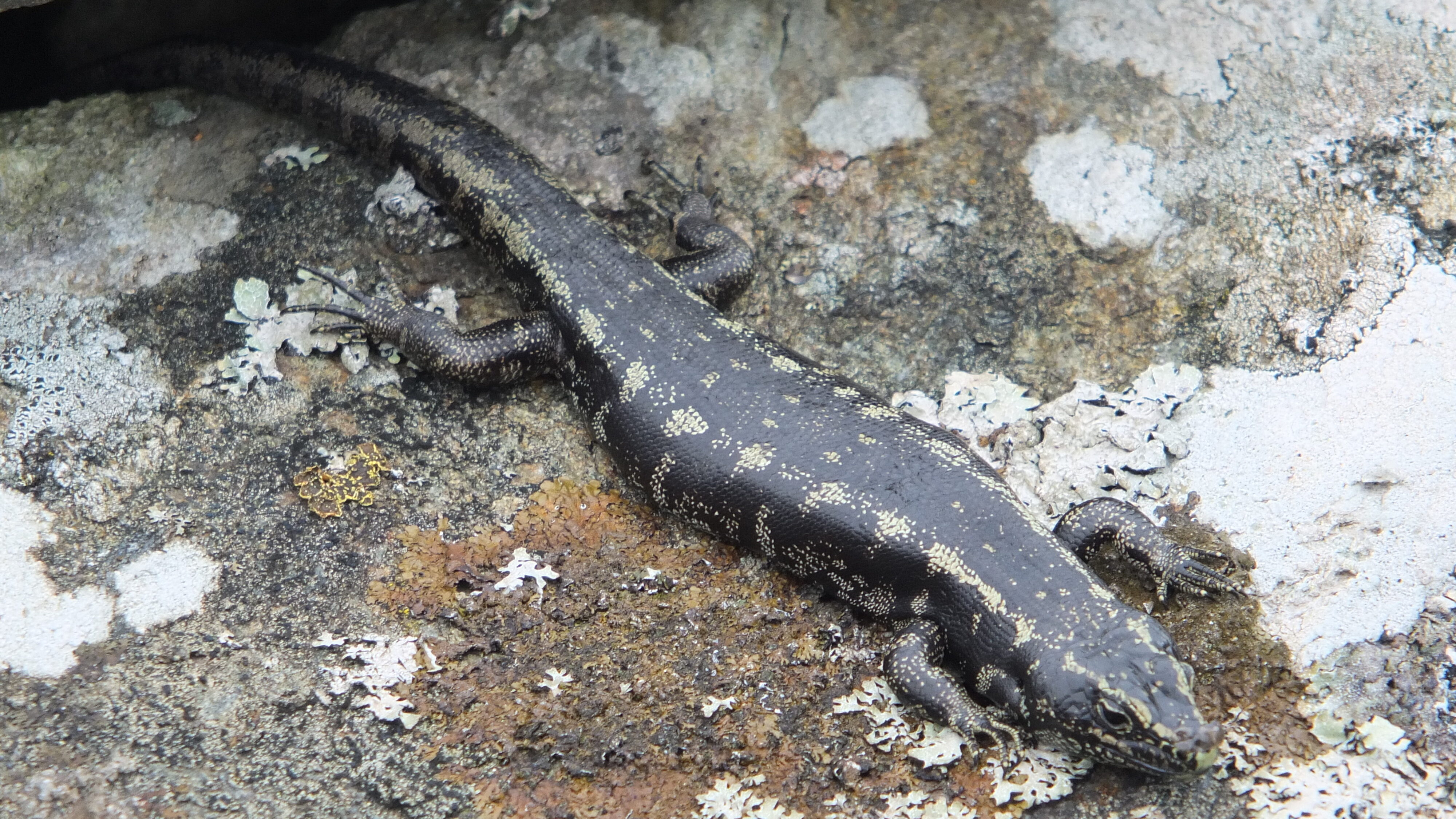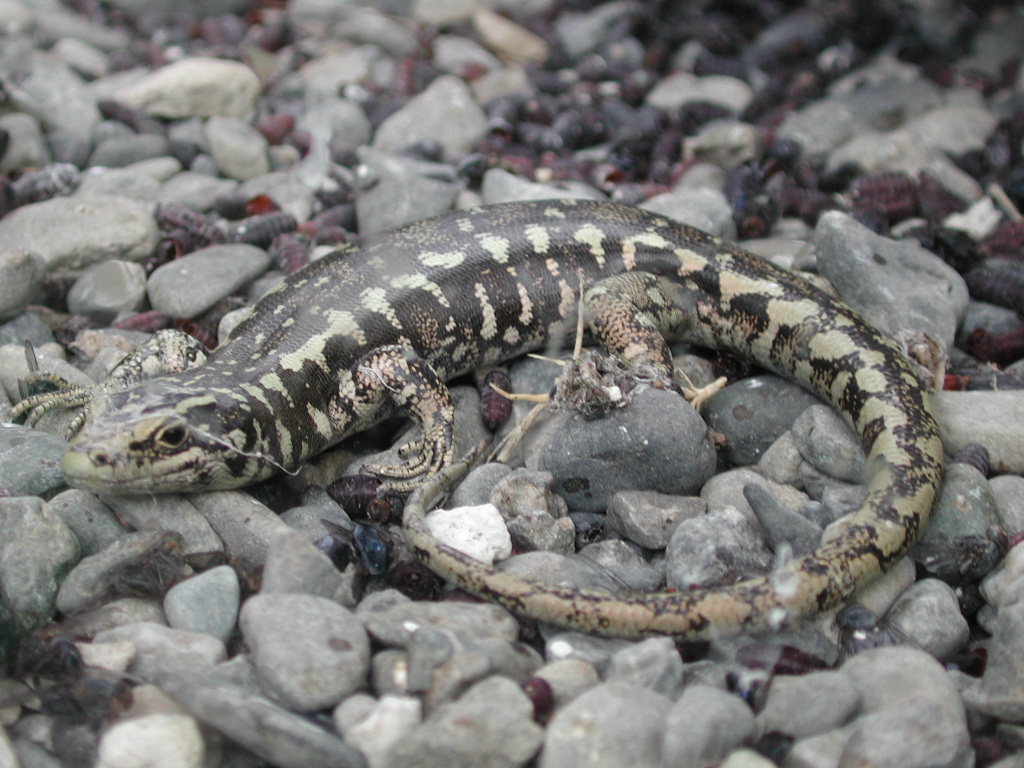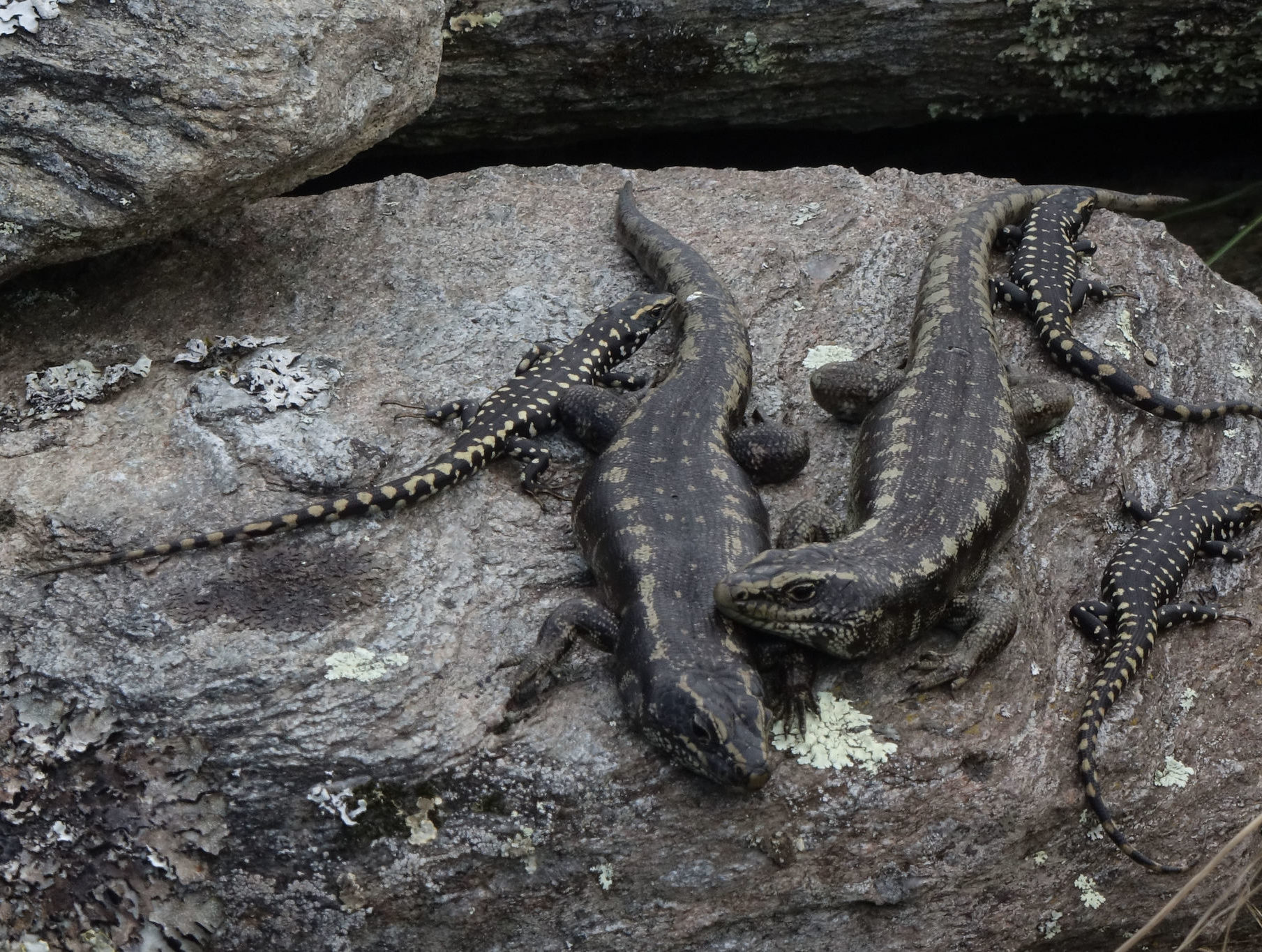Researchers have recently been studying the social life of our native skinks – and yes, skinks really do have a social network. Who would have thought it? Otago skinks (Oligosoma otagense) living in a large enclosure at Ōrokonui Ecosanctuary were the subjects of this unusual study of skink society.

The research was carried out by Vanitha Elangovan, Luke Bovill, Alison Cree, Joanne Monks and Stephanie Godfrey from the University of Otago’s Zoology Department who examined the social behaviour of Otago skinks over the course of 11 months. Their findings are published in the New Zealand Journal of Ecology.
The Otago skink is the largest and one of the rarest species of New Zealand lizards and is classified as Endangered by IUCN standards and as Nationally Endangered under our own national threat classification criteria. They live among rocks, especially schist rock outcrops that have extensive surfaces with numerous crevices, fissures and loose slabs.
Otago skinks are only found in the tussock-grassland habitats of the Otago region. In recent decades their distribution in the wild has declined, and their geographic ranges have severely contracted. leaving the species in relict populations. Habitat degradation and the invasion of mammal and bird predators are the main causes of their decline.
In addition to remnant wild populations, a small, translocated population of Otago skinks in an outdoor enclosure at Ōrokonui Ecosanctuary was established in November 2013. A total of 30 Otago skinks were initially released into a specially designed outdoor enclosure at Ōrokonui. The skinks were obtained from either zoos or private collections in the North Island.
“The oval-shaped enclosure has an approximate area of 109 square metres and consists of schist and other rock slabs, as well as tussocks and native shrubs, in order to closely resemble the skinks’ natural habitat. The rock tors in the enclosure provide the skinks with retreat sites that are 200–650 mm deep,” write the researchers, who began their project by taking reference photographs of skinks in November 2017, so that they could subsequently be identified by their individual markings.
“On 27 November 2017, 20 skinks (12 adults, 6 subadults, and 2 juveniles) were captured from the enclosure. Skinks were caught using a lizard lasso (i.e. a loop of string with a sliding knot at the end of a pole) and were weighed and measured. Sexing of the skinks was based on the presence of hemipenal ridges in males.”
Age of the skinks was also assessed.
“In this study, the snout-vent-length (SVL) of the skink determined whether it was an adult, subadult or juvenile. Skinks with an SVL of more than 100 mm were considered adults and skinks with an SVL of less than 70 mm were considered juveniles. Skinks whose SVLs measured between 70 mm and 100 mm were considered subadults. Other measurements recorded were each skink’s mass, tail length, and head width. The skinks were also photographed and the best photographs depicting the left- and right-hand sides of each skink, as the well as the dorsal surface, were archived in a photo library for individual identification.”

Photographic surveys of the enclosure were then regularly carried out in order to capture images of any social interactions occurring But what counts as ‘social interaction’ for a skink?
“The study of sociality in lizards has traditionally focussed on their territorial and mating behaviour. Recently, however, growing evidence has shown that sociality in lizard systems is more than just an artefact of sexual selection and territoriality. The emergence and evolution of sociality in reptiles have been strongly associated with species that exhibit two life-history traits: viviparity (live birth, not egg-laying) and longevity. The physical proximity between a mother and her offspring in viviparous reptiles may favour an evolutionary transition towards group living.”
In New Zealand with our cool climatic conditions, many lizard species are both viviparous and long-lived, making them prime candidates for an investigation into reptilian social behaviour.
“In this study, we aimed to quantify the aggregative behaviour, interaction patterns, and the stability of interaction patterns over time in Otago skinks at Ōrokonui. In addition, we documented the changes in interaction patterns in the population over time with and without the presence of juveniles. Skinks were considered interacting when they were seen touching or were within 10 cm of one another. An association, however, is defined as a stable interaction between skinks for an extended period of time (i.e. between seasons).”
Field work was conducted from November 2017 to October 2018.
“In order to document the social relationships between Otago skinks, visual photographic surveys were conducted; these involved photographing the lizards that were seen in the enclosure, and recording the location, date and time of each observation. For each observation, location information included on which of the eight rock tors it had been seen and where on the rock tor it had been seen (top, middle or bottom).”
“In general, photographic surveys were conducted twice per day, three times a week, between 0930 and 1230 (NZ Standard Time). However, in the austral winter (June, July and August) surveys were conducted twice per day, once a week between 1200 and 1500 (NZ Standard Time), when the weather was warm enough for the skinks to bask. In total, 112 photographic surveys were conducted over 57 days.”
Skinks were observed to be either solitary or interacting in groups consisting of two to eight individuals.
“Social network analysis was used to determine the strength of the interactions between adult males, adult females, subadults and juveniles. We assessed the stability of social interactions in the population over time by comparing the persistence of social interactions between seasons (summer, autumn/winter and winter/spring) while taking into account the size and composition of a social group.”

Interactions between adults and subadults were stable across autumn/winter and winter/spring whereas juveniles showed no stability in their interaction patterns during this time, the researchers found.
“During the course of the study, there was an overall stability in the social networks, indicating that the stability of social interactions present in the translocated population is largely driven by the adults and subadults in the enclosure. At Ōrokonui, the overall stability observed within the Otago skink population is biologically representative of particular pairs of individuals having sustained relationships that last beyond the mating period, as well as pairs of individuals that never interacted with each other, despite their close spatial proximity.”
Parental care may have accounted for many of the adult/juvenile interactions.
“The second most common interaction type observed in the population at Ōrokonui Ecosanctuary was between adult females and juveniles, followed by adult males and juveniles. The juveniles clustered in the enclosure were often seen associating with one adult male and one adult female. Parental care occurs in situations where the costs of parental expenditure are outweighed by fitness benefits for the offspring. Contrary to the situation in mammals and birds, however, parental care in lizards typically involves the offspring not being fed, but instead, protected.”
The researchers hope that an improved understanding of social interactions within a skink population will help improve their conservation management.
“As sociality is a fundamental aspect of living, studying the sociality of Otago skinks can be of value towards understanding the complex behavioural dynamics of a translocated population. Obtaining a better insight into the sociality of captive Otago skinks may then allow for the improved management of this population at Ōrokonui and in other potential captive or managed populations, including in situations that involve reintroductions or removal of individuals. Our work suggests that incorporating an understanding of sociality into capture procedures may minimise disruption to social structures and ultimately improve outcomes of translocation.”
Social behaviour had previously been observed in Otago skinks, but little was known about the stability and structure of social interactions in these lizards.
“This study involves the longest duration over which sociality has been observed in Otago skinks; we documented interactions over an 11-month period, providing evidence towards the presence of sustained relationships and group living in this species. This study has also observed group sizes of up to 8, and this is larger than previous recordings of 2 to 4. However, habitats and population densities can potentially affect the social behaviour of reptiles. Therefore, it is important to acknowledge the artificial situation at Ōrokonui Ecosanctuary, where individuals are potentially forced into closer interactions, as opposed to the interactions formed within wild populations at lower density. Our research paves the way for taking an experimental approach in future translocations to determine if social structure does indeed affect translocation outcomes.”
The full research paper is published in the New Zealand Journal of Ecology and freely available online.
More stories and research about our endemic skinks:

